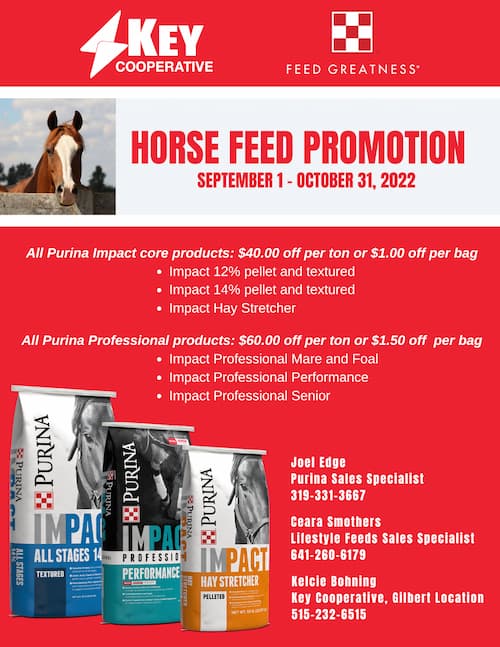Hay Shortage? Explore Other Options for Your Horse
Oct 01, 2022
Marissa Eekhoff & Ellie Moser
2022 Feed Interns
Supplemental complete feeds, hay, pasture - these are all words that can be used to describe a source of roughage and fiber that your horse requires. This summer and fall, we’ve certainly been hurting for rain across central and southern Iowa. Drought conditions make good quality hay difficult to produce and hard to find. Just like humans, horses have specific nutritional requirements. In order to help your horse’s gut function properly, they need at least one percent of their body weight in good quality fiber per day (a 1,200 pound horse needs 12 pounds of fiber at a minimum).
There are several indicators of a high quality hay. These indicators include: the diameter of the stem, the leaf to stem ratio, the seed heads or blooms, the color, and the smell. The diameter of the stem should be smaller because this indicates that the plant was less mature when it was cut. The leaf to stem ratio should be higher in the leaf content, also indicating that the plant was not as mature when it was cut. When selecting a high quality hay, you don’t want to see many, if any, seed heads or blooms. The color of the hay should be bright green with a slight bit of fading. If the hay is yellow, brown, or black, it could indicate poor quality or molded hay. A good quality hay should smell fresh, not musty; this will help make the hay more appetizing.
Key Cooperative offers some great forage alternatives for those who may be unable to find good quality forages. Those alternatives are Purina Omolene 400 and Purina Impact Hay Stretcher. These feeds can be used as a partial roughage replacement or a complete roughage replacement. If you choose to use them as a partial replacement, you would feed 50% of your hay or roughage and ½ - 1½ pounds of the complete feed a day. If you choose to use them as a complete replacement, you would not feed any hay or roughage and instead feed 2 - 3 pounds of the complete feed a day. Feeding some long stem, lower quality hay can be beneficial because it allows for a “chew factor”.
Iowa State University has written an article you may find helpful, in which they provide a great resource: a hay locator. The article contains a directory by the Iowa Department of Land and Stewardship that can help you locate a new seller in your area.
The Key Cooperative Feed Team is here to help you figure out the best solution to any hay or roughage shortage issues you may be facing. Whether it is finding roughage sources, the proper partial replacement for your horses, or a great complete replacement option – we want to help find the best products for you!
The Purina Impact Hay Stretcher featured in this article is included in our current horse feed promotion:

2022 Feed Interns
Supplemental complete feeds, hay, pasture - these are all words that can be used to describe a source of roughage and fiber that your horse requires. This summer and fall, we’ve certainly been hurting for rain across central and southern Iowa. Drought conditions make good quality hay difficult to produce and hard to find. Just like humans, horses have specific nutritional requirements. In order to help your horse’s gut function properly, they need at least one percent of their body weight in good quality fiber per day (a 1,200 pound horse needs 12 pounds of fiber at a minimum).
There are several indicators of a high quality hay. These indicators include: the diameter of the stem, the leaf to stem ratio, the seed heads or blooms, the color, and the smell. The diameter of the stem should be smaller because this indicates that the plant was less mature when it was cut. The leaf to stem ratio should be higher in the leaf content, also indicating that the plant was not as mature when it was cut. When selecting a high quality hay, you don’t want to see many, if any, seed heads or blooms. The color of the hay should be bright green with a slight bit of fading. If the hay is yellow, brown, or black, it could indicate poor quality or molded hay. A good quality hay should smell fresh, not musty; this will help make the hay more appetizing.
Key Cooperative offers some great forage alternatives for those who may be unable to find good quality forages. Those alternatives are Purina Omolene 400 and Purina Impact Hay Stretcher. These feeds can be used as a partial roughage replacement or a complete roughage replacement. If you choose to use them as a partial replacement, you would feed 50% of your hay or roughage and ½ - 1½ pounds of the complete feed a day. If you choose to use them as a complete replacement, you would not feed any hay or roughage and instead feed 2 - 3 pounds of the complete feed a day. Feeding some long stem, lower quality hay can be beneficial because it allows for a “chew factor”.
Iowa State University has written an article you may find helpful, in which they provide a great resource: a hay locator. The article contains a directory by the Iowa Department of Land and Stewardship that can help you locate a new seller in your area.
The Key Cooperative Feed Team is here to help you figure out the best solution to any hay or roughage shortage issues you may be facing. Whether it is finding roughage sources, the proper partial replacement for your horses, or a great complete replacement option – we want to help find the best products for you!
The Purina Impact Hay Stretcher featured in this article is included in our current horse feed promotion:
